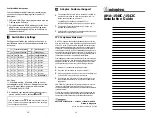
Fabric OS 6.2 administrator guide 163
5
Maintaining the switch configuration file
This chapter provides procedures for basic switch configuration maintenance.
Configuration settings
It is important to maintain consistent configuration settings on all switches in the same fabric because
inconsistent parameters, such as inconsistent PID formats, can cause fabric segmentation. As part of
standard configuration maintenance procedures, HP recommends that you back up all important
configuration data for every switch on a host computer server for emergency reference.
NOTE:
For information about AD-enabled switches using Fabric OS 5.2.0 or later, see Chapter 7,
”
Managing administrative domains
” on page 191.
There are two ways to view configuration settings for a switch in a B-Series fabric:
•
Enter the
configShow -all
command.
To display configuration settings, connect to the switch, log in as admin, and enter the
configShow
-all
command. The configuration settings vary depending on switch model and configuration. This
command does not show as much configuration information as the text file created from the
configUpload
command.
•
Enter the
configUpload
command to upload an ASCII text file from the switch or switch module.
You can open the text file with a text file editor to view the configuration information of the switch.
CAUTION:
Editing of the uploaded file is unsupported and can result in system errors if an edited
file is subsequently downloaded.
Configuration file format
In Fabric OS 6.2.0 the configuration file is divided into three areas: the header, the chassis section, and
one or more switch sections. If you upgrade the firmware on any existing switches from pre-Fabric OS
6.2.0 to 6.2.0, you must perform the
configUpload
command to upload both chassis and switch
information.
Summary of Contents for A7533A - Brocade 4Gb SAN Switch Base
Page 1: ...HP StorageWorks Fabric OS 6 2 administrator guide Part number 5697 0016 Edition May 2009 ...
Page 24: ...24 ...
Page 99: ...Fabric OS 6 2 administrator guide 99 ...
Page 100: ...100 Managing user accounts ...
Page 118: ...116 Configuring standard security features ...
Page 164: ...162 Configuring advanced security features ...
Page 234: ...232 Installing and maintaining firmware ...
Page 268: ...266 Administering advanced zoning ...
Page 284: ...282 Configuring Enterprise class platforms ...
Page 292: ...290 Routing traffic ...
Page 294: ...292 Interoperability for merged SANs ...
Page 302: ...300 Configuring the Distributed Management Server ...
Page 334: ...332 iSCSI gateway service ...
Page 340: ...338 Administering NPIV ...
Page 407: ...Fabric OS 6 2 administrator guide 405 ...
Page 408: ...406 Using the FC FC routing service ...
Page 438: ...434 Administering extended fabrics ...
Page 460: ...456 Administering ISL trunking ...
Page 516: ...512 FICON fabrics ...
Page 526: ...522 Configuring and monitoring FICON Extension Services ...
Page 540: ...536 Configuring the PID format ...
Page 544: ...540 Understanding legacy password behavior ...
Page 546: ...542 Mixed fabric configurations for non merge SANs ...
Page 550: ...546 Migrating from an MP Router to a 400 MP Router ...
Page 558: ...554 Inband Management ...
Page 572: ...568 ...
















































